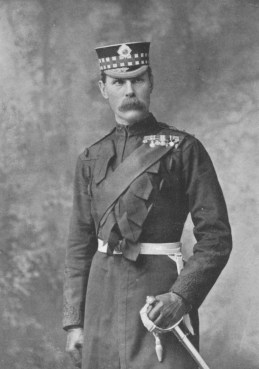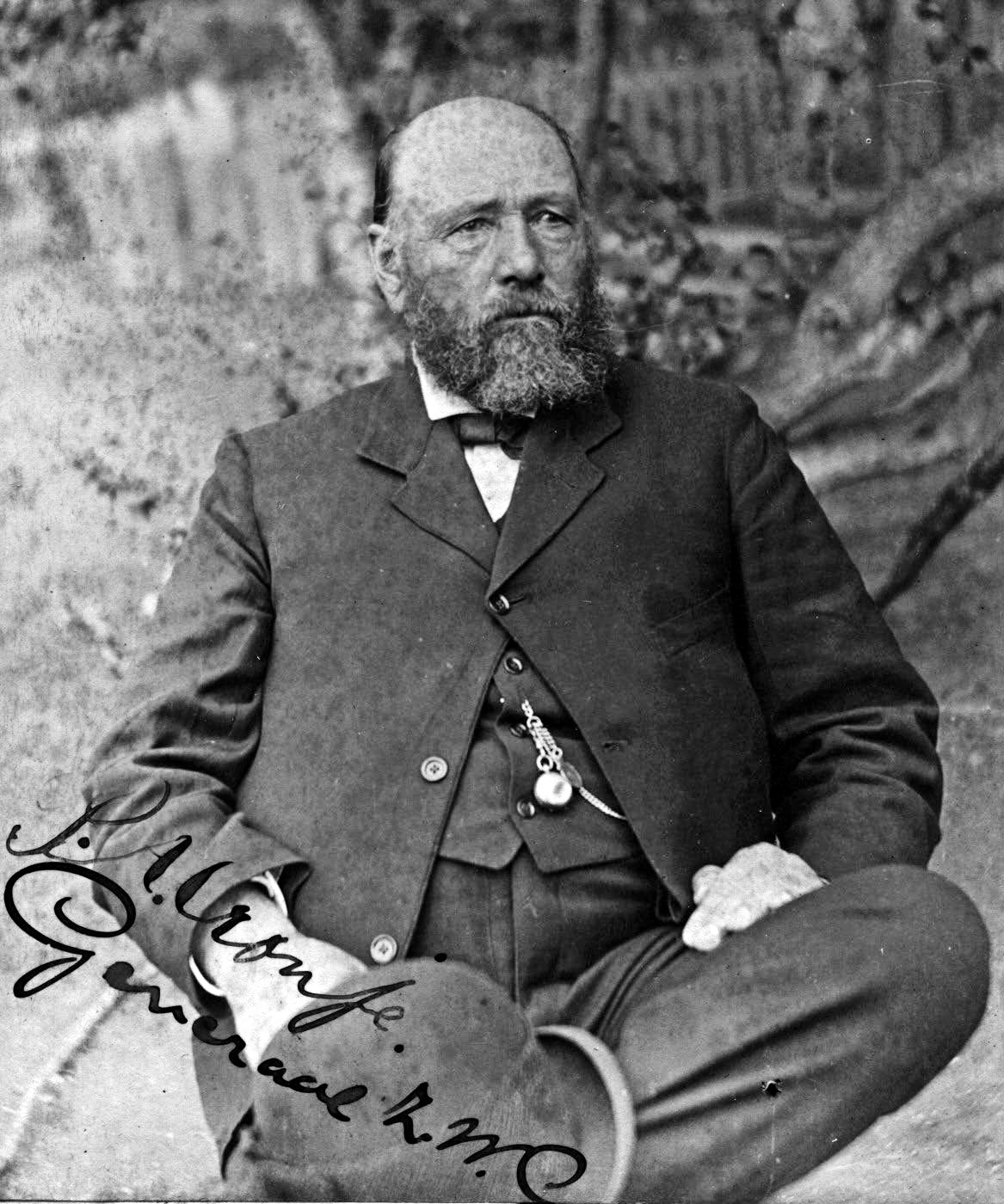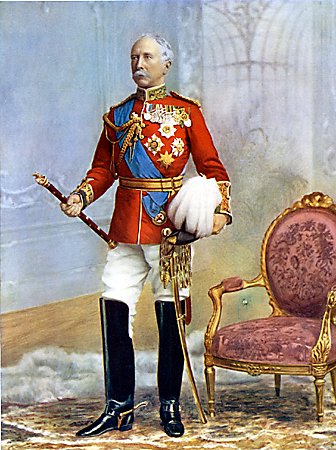 |
Paul Methuen, 3rd Baron Methuen
Field Marshal Paul Sanford Methuen, 3rd Baron Methuen, (1 September 1845 – 30 October 1932) was a British Army officer. He served in the Third Anglo-Ashanti War in 1873 and then in the expedition of Sir Charles Warren to Bechuanaland in the mid-1880s. He took a prominent role as General Officer Commanding the 1st Division in the Second Boer War. He suffered a serious defeat at the Battle of Magersfontein, during which he failed to carry out adequate reconnaissance and accordingly his artillery bombarded the wrong place leading to the Highland Brigade taking heavy casualties. He was later captured by the Boers at Tweebosch. After the war, he became General Officer Commanding-in-Chief in South Africa in 1908, Governor and Commander-in-Chief of Natal in 1910 and then Governor and Commander-in-Chief of Malta in 1915. Early life Paul Sanford Methuen was born at Corsham Court, Wiltshire, the eldest of three sons of Frederick Methuen, 2nd Baron Methuen and his wife Anna Ho ... [...More Info...] [...Related Items...] OR: [Wikipedia] [Google] [Baidu] |
 |
Corsham Court
Corsham Court is an English country house in a park designed by Capability Brown. It is in the town of Corsham, 3 miles (5 km) west of Chippenham, Wiltshire, and is notable for its fine art collection, based on the nucleus of paintings inherited in 1757 by Paul Methuen from his uncle, Sir Paul Methuen, the diplomat. It is currently the home of the present Baron Methuen, James Methuen-Campbell, the eighth generation of the Methuens to live there. Early history Corsham was a royal manor in the days of the Saxon kings, reputed to have been a seat of Ethelred the Unready. After William the Conqueror, the manor continued to be passed down through the generations in the royal family. It often formed part of the dower of the Queens of England during the late 14th and early 15th centuries, becoming known as ''Corsham Reginae''. During the 16th century, the manor went to two of Henry VIII's wives, namely Catherine of Aragon until 1536, and Katherine Parr until 1548. During ... [...More Info...] [...Related Items...] OR: [Wikipedia] [Google] [Baidu] |
 |
Battle Of Magersfontein
The Battle of MagersfonteinSpelt incorrectly in various English texts as "Majersfontein", "Maaghersfontein" and "Maagersfontein". ( ) was fought on 11 December 1899, at Magersfontein, near Kimberley, South Africa, on the borders of the Cape Colony and the independent republic of the Orange Free State. British forces under Lieutenant General Lord Methuen were advancing north along the railway line from the Cape to relieve the siege of Kimberley, but their path was blocked at Magersfontein by a Boer force that was entrenched in the surrounding hills. The British had already fought a series of battles with the Boers, most recently at Modder River, where the advance was temporarily halted. Lord Methuen failed to perform adequate reconnaissance in preparation for the impending battle and was unaware that Boer ''Vecht-generaal'' (Combat General) De la Rey had entrenched his forces at the foot of the hills, rather than the forward slopes, as was the accepted practice. That allowed t ... [...More Info...] [...Related Items...] OR: [Wikipedia] [Google] [Baidu] |
|
Attaché
In diplomacy, an attaché is a person who is assigned ("to be attached") to the diplomatic or administrative staff of a higher placed person or another service or agency. Although a loanword from French, in English the word is not modified according to gender. An attaché is normally an official, who serves either as a diplomat or as a member of the support staff, under the authority of an ambassador or other head of a diplomatic mission, mostly in intergovernmental organizations or international non-governmental organisations or agencies. Attachés monitor various issues related to their area of specialty (see examples below) that may require some action. To this end, attachés may undertake the planning for events to be attended, decisions which will be taken, managing arrangements and agendas, conducting research, and acting as a representative of the interests of their state when necessary, to the types of organizations mentioned above, and also to national academies and to i ... [...More Info...] [...Related Items...] OR: [Wikipedia] [Google] [Baidu] |
|
|
Lieutenant Colonel
Lieutenant colonel ( , ) is a rank of commissioned officers in the armies, most marine forces and some air forces of the world, above a major and below a colonel. Several police forces in the United States use the rank of lieutenant colonel. The rank of lieutenant colonel is often shortened to simply "colonel" in conversation and in unofficial correspondence. Sometimes, the term 'half-colonel' is used in casual conversation in the British Army. In the United States Air Force, the term 'light bird' or 'light bird colonel' (as opposed to a 'full bird colonel') is an acceptable casual reference to the rank but is never used directly towards the rank holder. A lieutenant colonel is typically in charge of a battalion or regiment in the army. The following articles deal with the rank of lieutenant colonel: * Lieutenant-colonel (Canada) * Lieutenant colonel (Eastern Europe) * Lieutenant colonel (Turkey) * Lieutenant colonel (Sri Lanka) * Lieutenant colonel (United Kingdom) * ... [...More Info...] [...Related Items...] OR: [Wikipedia] [Google] [Baidu] |
|
 |
Garnet Wolseley
Field Marshal Garnet Joseph Wolseley, 1st Viscount Wolseley, (4 June 183325 March 1913), was an Anglo-Irish officer in the British Army. He became one of the most influential and admired British generals after a series of successes in Canada, West Africa and Egypt, followed by a central role in modernizing the British Army in promoting efficiency. He served in Burma, the Crimean War, the Indian Mutiny, China, Canada and widely throughout Africa—including his Ashanti campaign (1873–1874) and the Nile Expedition against Mahdist Sudan in 1884–85. Wolseley served as Commander-in-Chief of the Forces from 1895 to 1900. His reputation for efficiency led to the late 19th century English phrase "everything's all Sir Garnet", meaning, "All is in order." Early life and education Lord Wolseley was born into a prominent Anglo-Irish family in Dublin, the eldest son of Major Garnet Joseph Wolseley of the King's Own Scottish Borderers (25th Foot) and Frances Anne Wolseley (''née'' ... [...More Info...] [...Related Items...] OR: [Wikipedia] [Google] [Baidu] |
|
Captain (British Army And Royal Marines)
Captain (Capt) is a junior officer rank of the British Army and Royal Marines and in both services it ranks above lieutenant and below major with a NATO ranking code of OF-2. The rank is equivalent to a lieutenant in the Royal Navy and to a flight lieutenant in the Royal Air Force. The rank of captain in the Royal Navy is considerably more senior (equivalent to the Army/RM rank of colonel) and the two ranks should not be confused. In the 21st-century British Army, captains are often appointed to be second-in-command (2IC) of a company A company, abbreviated as co., is a Legal personality, legal entity representing an association of people, whether Natural person, natural, Legal person, legal or a mixture of both, with a specific objective. Company members share a common p ... or equivalent sized unit of up to 120 soldiers. History A rank of second captain existed in the Ordnance at the time of the Battle of Waterloo. From 1 April 1918 to 31 July 1919, the Roy ... [...More Info...] [...Related Items...] OR: [Wikipedia] [Google] [Baidu] |
|
|
Ensign (rank)
Ensign (; Late Middle English, from Old French (), from Latin (plural)) is a junior rank of a commissioned officer in the armed forces of some countries, normally in the infantry or navy. As the junior officer in an infantry regiment was traditionally the carrier of the ensign flag, the rank acquired the name. This rank has generally been replaced in army ranks by second lieutenant. Ensigns were generally the lowest-ranking commissioned officer, except where the rank of subaltern existed. In contrast, the Arab rank of ensign, لواء, '' liwa''', derives from the command of units with an ensign, not the carrier of such a unit's ensign, and is today the equivalent of a major general. In Thomas Venn's 1672 ''Military and Maritime Discipline in Three Books'', the duties of ensigns are to include not only carrying the color but assisting the captain and lieutenant of a company and in their absence, have their authority. "Ensign" is ''enseigne'' in French, and '' chorąży'' i ... [...More Info...] [...Related Items...] OR: [Wikipedia] [Google] [Baidu] |
|
 |
Scots Guards
The Scots Guards (SG) is one of the five Foot Guards regiments of the British Army. Its origins are as the personal bodyguard of King Charles I of England and Scotland. Its lineage can be traced back to 1642, although it was only placed on the English Establishment (thus becoming part of what is now the British Army) in 1686. History Formation; 17th century The regiment now known as the Scots Guards traces its origins to the Marquis of Argyll's Royal Regiment, a unit raised in 1642 by Archibald Campbell, 1st Marquess of Argyll in response to the Irish Rebellion of 1641, 1641 Irish Rebellion. After the Restoration (England), Restoration of Charles II, the George Livingston, 3rd Earl of Linlithgow, Earl of Linlithgow received a commission dated 23 November 1660 to raise a regiment which was called The Scottish Regiment of Footguards. It served in the Battle of Bothwell Bridge, 1679 Covenanter rising of 1679, as well as Argyll's Rising in June 1685, after which it was expanded to ... [...More Info...] [...Related Items...] OR: [Wikipedia] [Google] [Baidu] |
|
Royal Wiltshire Yeomanry
The Royal Wiltshire Yeomanry (RWY) was a Yeomanry regiment of the Kingdom of Great Britain and the United Kingdom established in 1794. It was disbanded as an independent Territorial Army unit in 1967, a time when the strength of the Territorial Army was greatly reduced. The regiment lives on in B (Royal Wiltshire Yeomanry) and Y (Royal Wiltshire Yeomanry) Squadrons of the Royal Wessex Yeomanry. The regiment took part in the Second Boer War as part of the Imperial Yeomanry. In the First World War, it fought on the Western Front, but saw relatively little action as horsed cavalry. After conversion to infantry, it fought in the trenches, notably during 3rd Ypres in 1917 and during the German spring offensive in 1918. In the Second World War, the regiment fought in the Middle East, seeing action in Syria against Vichy French forces, as well as operations in Iraq and Iran. It then joined 9th Armoured Brigade, seeing action in North Africa and Italy. With this formation, it took ... [...More Info...] [...Related Items...] OR: [Wikipedia] [Google] [Baidu] |
|
 |
Cornet (rank)
Cornet was originally the lowest grade of commissioned officer in a British cavalry troop, the modern equivalent being a second lieutenant. The rank was abolished by the 1871 Cardwell Reforms, which replaced it with sub-lieutenant. Although obsolete, the term is still used when referring to a newly commissioned officer (the equivalent of a second lieutenant) within the British Army regiment of the Blues and Royals. The cornet rank was also used by other nations such as the Imperial Russian Army and the Prussians. Etymology A ''cornet'' or "cornet of horse" was in the 17th and 18th century a term for a group of cavalry (typically 100–300 men), so-called because it was accompanied by a cornet player (a trumpet-like instrument, from Latin ''cornū'', "horn"). Later "cornet" came to refer to the fifth commissioned officer in a cavalry troop, who carried the colours; it never referred to the cornet player himself. An alternative etymology claims that the term is derived from ... [...More Info...] [...Related Items...] OR: [Wikipedia] [Google] [Baidu] |
|
Eton College
Eton College () is a Public school (United Kingdom), public school in Eton, Berkshire, England. It was founded in 1440 by Henry VI of England, Henry VI under the name ''Kynge's College of Our Ladye of Eton besyde Windesore'',Nevill, p. 3 ff. intended as a sister institution to King's College, Cambridge, making it the 18th-oldest Headmasters' and Headmistresses' Conference (HMC) school. Eton is particularly well-known for its history, wealth, and notable alumni, called :People educated at Eton College, Old Etonians. Eton is one of only three Public school (United Kingdom)#21st century, public schools, along with Harrow School, Harrow (1572) and Radley College, Radley (1847), to have retained the boys-only, boarding-only tradition, which means that its boys live at the school seven days a week. The remainder (such as Rugby School, Rugby in 1976, Charterhouse School, Charterhouse in 1971, Westminster School, Westminster in 1973, and Shrewsbury School, Shrewsbury in 2015) have sinc ... [...More Info...] [...Related Items...] OR: [Wikipedia] [Google] [Baidu] |
|
 |
Paul Methuen, 3rd Baron Methuen
Field Marshal Paul Sanford Methuen, 3rd Baron Methuen, (1 September 1845 – 30 October 1932) was a British Army officer. He served in the Third Anglo-Ashanti War in 1873 and then in the expedition of Sir Charles Warren to Bechuanaland in the mid-1880s. He took a prominent role as General Officer Commanding the 1st Division in the Second Boer War. He suffered a serious defeat at the Battle of Magersfontein, during which he failed to carry out adequate reconnaissance and accordingly his artillery bombarded the wrong place leading to the Highland Brigade taking heavy casualties. He was later captured by the Boers at Tweebosch. After the war, he became General Officer Commanding-in-Chief in South Africa in 1908, Governor and Commander-in-Chief of Natal in 1910 and then Governor and Commander-in-Chief of Malta in 1915. Early life Paul Sanford Methuen was born at Corsham Court, Wiltshire, the eldest of three sons of Frederick Methuen, 2nd Baron Methuen and his wife Anna Ho ... [...More Info...] [...Related Items...] OR: [Wikipedia] [Google] [Baidu] |